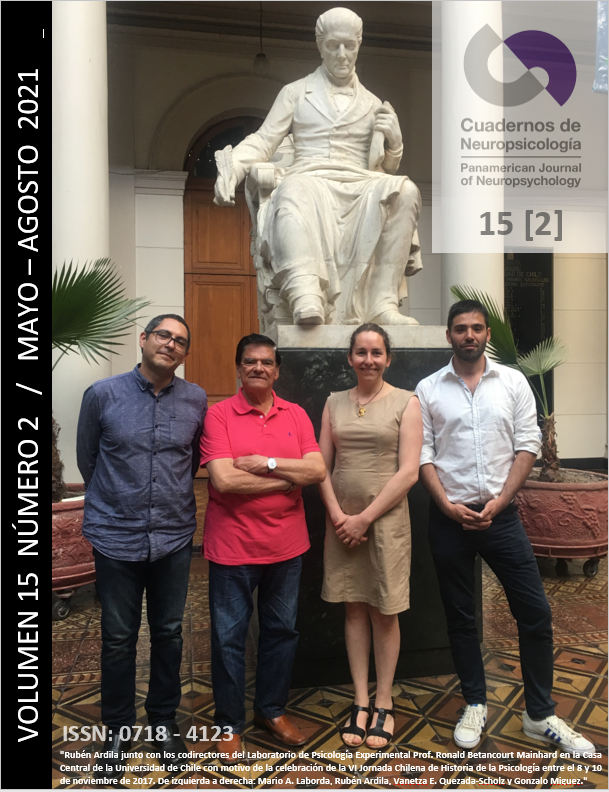Diferencias individuales en la producción de expresiones emocionales en niñas y niños durante una tarea de inhibición y flexibilidad con diferente contenido emocional
Abstract
R E S U M E N
Una emoción puede definirse como un episodio que se desencadena ante una causa o evento y conformada por los componentes cognitivo, motivacional, somático, expresivo y subjetivo. La bibliografÃa en muestras de niñas/os, en relación al componente expresivo, se encargó de demostrar el efecto de la edad y el género sobre la producción de las expresiones emocionales, pero se excluyó del análisis cómo el contenido de una tarea cognitiva modula su producción. Los objetivos de este estudio cuantitativo son describir las expresiones emocionales en 54 niñas/os de entre cuatro y ocho años ante una tarea tipo Stroop con demanda de inhibición y flexibilidad con y sin contenido emocional; y analizar cómo la edad, género y condición de la tarea modulan la producción de expresiones emocionales. Los resultados evidencian que las categorÃas más frecuentes fueron Boca y Toques; y se comprobaron los efectos moduladores de la edad/escolaridad, género y contenido de la tarea sobre la producción de las expresiones emocionales.
Palabras Clave: Reporte de investigación; expresiones emocionales; niñas y niños; diferencias individuales; procesamiento emocional; Stroop.
Â
A B S T R A C T
An emotion can be defined as an episode triggered by a cause and constituted by a cognitive, motivational, somatic, expressive and subjective components. In regard with the expressive component, the literature in children has shown the effect of age and gender on the production of emotional expressions, but the effect of the content of the task has been omitted from the analysis. The aim of this quantitative study is to describe the emotional expressions of 54 children from 4 to 8 years old during an inhibition and flexibility Stroop-like task with and without emotional content; and analyze de effect of age, gender and content of the task in the production of emotional expressions. The results show that the most frequent expressions were Mouth and Touches; and the modulating effect of age/schooling, gender and content of the task on the production of emotional expressions.
Keywords: Emotional expressions; children; individual differences; emotional processing; Stroop.
Â
R E S U M O
Uma emoção pode definir-se como um episódio que se desencadeia ante uma causa ou evento e conformada pelos componentes cognitivo, motivacional, somático, expressivo e subjetivo. A bibliografia em amostras de crianças, em relação ao componente expressivo, encarregou-se de demonstrar o efeito da idade e do género sobre a produção das expressões emocionais, mas se excluiu da análise como o conteúdo de uma tarefa cognitiva modula sua produção. Os objetivos deste estudo quantitativo são descrever as expressões emocionais em 54 crianças entre 4 e 8 anos diante de uma tarefa tipo Stroop com demanda de inibição e flexibilidade com e sem conteúdo emocional; e analisar como a idade, género e condição da tarefa modulam a produção de expressões emocionais. Os resultados evidenciam que as categorias mais freqüentes foram Boca e Toques; e se comprovaram os efeitos moduladores da idade/escolaridade, género e conteúdo da tarefa sobre a produção das expressões emocionais.
Palavras-chave: Reporte de investigación; expresión emocionales; crianças; diferencias individuais; proceso emocional; Stroop.
Downloads
How to Cite
Issue
Section
License
Articles published in this journal are protected under the Creative Commons Attribution-NonCommercial-ShareAlike 4.0 International (CC BY-NC-SA 4.0) license. This means that authors retain full rights over their research and publications at all times. As a journal, we fully respect and promote the principles of open access established by this license, allowing the work to be shared, adapted, and distributed for non-commercial purposes, provided that appropriate credit is given to the authors and any derivative works are licensed under the same terms.
Authors are responsible for obtaining the required permission when they wish to reproduce part of the material (figures, etc.) from other publications.
Likewise, CNPs allows authors to host in their personal sites or other repositories that they deem convenient the Final and Definitive Version of the published article with the format assigned by the journal. In no case do we allow access to preprints of the article under evaluation or already published.
When submitting an article to CNPs you are aware that all the contents of CNPs are under a Creative Commons License. In which it is allowed to copy and share the contents freely, always making reference to the origin of the publication and its author.





